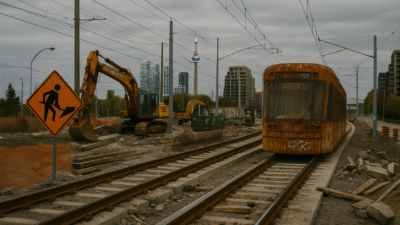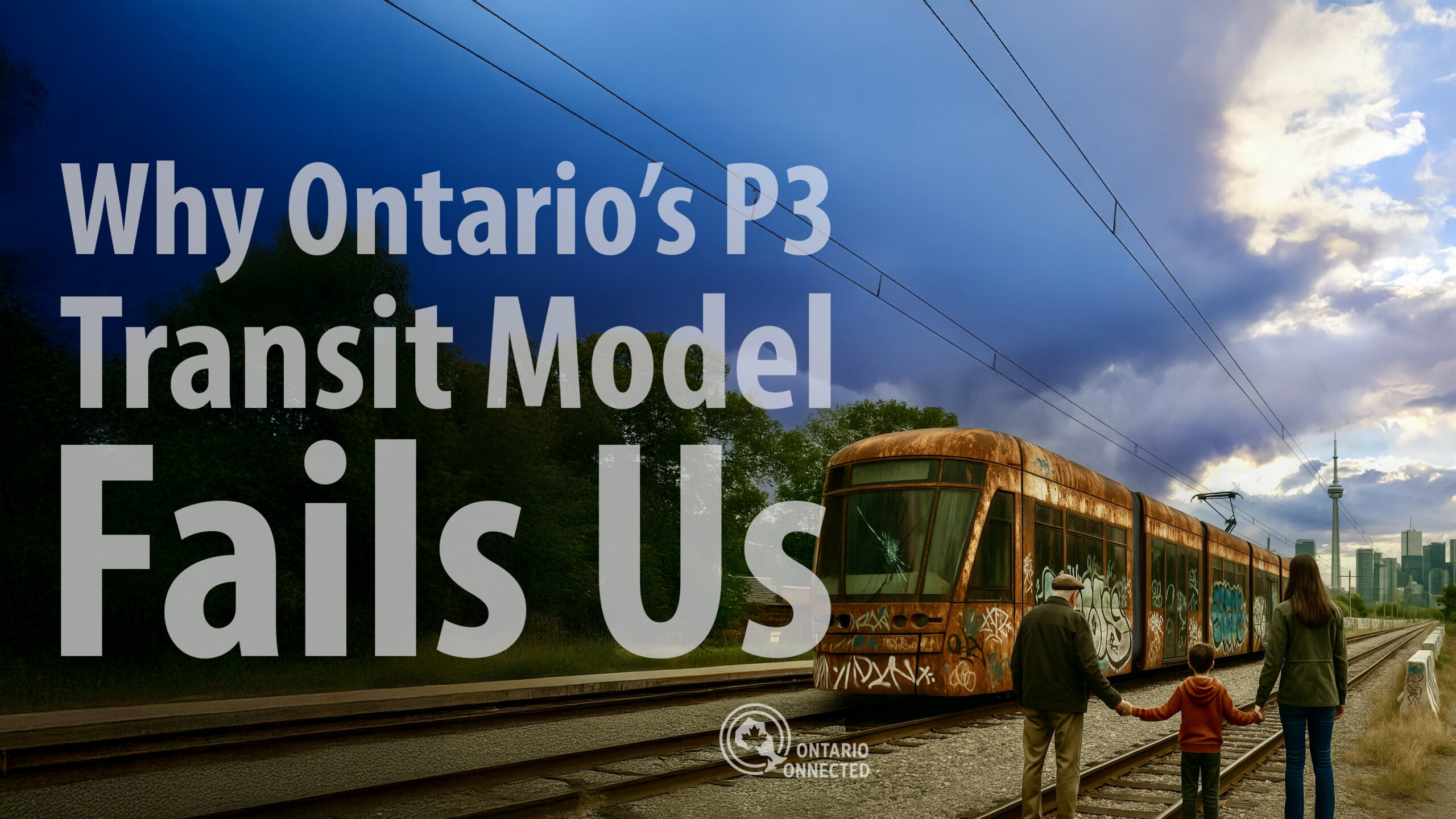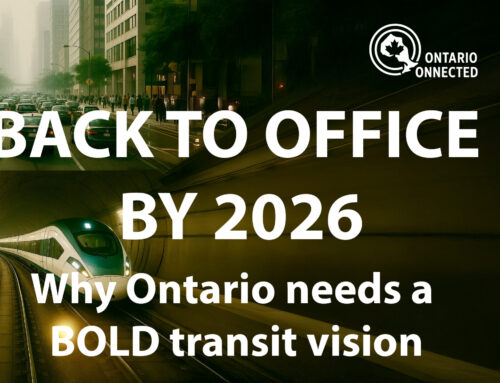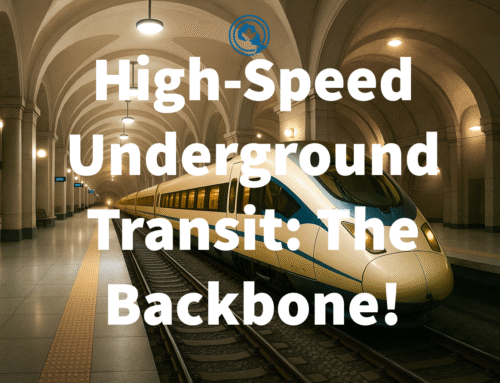Ontario is growing rapidly, and transit is supposed to be the backbone of that growth. But ask any commuter in Toronto or Ottawa what they think about our “world-class” projects, and you’ll hear the same story: delays, overruns, and frustration.
Two letters explain a lot of it: P3 — Public–Private Partnership.
For nearly two decades, Ontario governments have leaned on P3s to deliver major transit projects. They were supposed to save money, shift risk away from taxpayers, and get projects built faster. In practice, they’ve delivered the opposite: ballooning costs, endless delays, and contracts that put accountability out of reach.
It’s time to face the truth: the P3 model is failing Ontarians.
What Exactly Is a P3?
In a Public–Private Partnership, the government hires a private consortium (often made up of construction firms, financiers, and operators) to design, build, finance, and sometimes maintain or operate a project.
The sales pitch sounds great:
- Private companies take on risk.
- Projects get built faster.
- Taxpayers supposedly save money.
But as many Ontarians have learned the hard way, P3s for transit don’t match the hype.
Where P3s Have Failed Ontarians
Eglinton Crosstown (Toronto)
- Launched in 2011 with an original opening target of 2020.
- Now over four years late and billions over budget.
- Costs have risen well beyond the initial $5.5 billion price tag.
- Problems with track, signals, and construction defects are tied up in disputes between Metrolinx and the private consortium Crosslinx.
Instead of one accountable builder, you have layers of private partners pointing fingers at each other — while riders wait.
Ottawa LRT
- Opened in 2019 under a P3 with Rideau Transit Group.
- Within months: repeated breakdowns, door malfunctions, even derailments.
- In 2022, a public inquiry concluded that the system had been rushed, oversight was poor, and private partners cut corners to meet political deadlines.
- The Commissioner’s report bluntly said: “The City’s adoption of the P3 model contributed to many of the problems.”
Other Projects
Even beyond transit, Ontario’s record with P3s is spotty. Auditor General reports have shown that many hospital and highway projects ended up costing taxpayers billions more than if the government had financed and managed them directly.
Why P3s Don’t Work for Transit
Transit projects are not like highways or hospitals. They involve:
- Complex systems integration (signals, power, rolling stock).
- Operations that need flexibility and constant adjustment.
- A public that demands safety and reliability above profit.
Here’s why P3s consistently stumble:
- Profit vs. Public Interest – Private partners want guaranteed returns. Transit riders want affordability and reliability. Those goals often clash.
- Accountability Disappears – When something goes wrong, governments blame contractors, contractors blame subcontractors, and riders are stuck in the middle.
- Risk Transfer Is a Myth – Governments claim risk is “transferred” to the private sector. In reality, when projects fail, it’s still the taxpayer who bails them out.
- Lock-In & Inflexibility – Once a P3 contract is signed, it’s extremely hard to adapt to new realities. Technology changes, ridership patterns evolve, but the contract keeps ticking — with penalties for change.
The Bigger Problem: Politics and Short-Term Thinking

The reliance on P3s isn’t just about construction models — it’s also about politics.
For 40 years, Ontario has suffered from short-term, election-driven planning:
- Governments want ribbon-cuttings before the next election.
- Politicians outsource risk so they can say “the private sector is on the hook.”
- When things go wrong, they deflect blame.
Meanwhile, transit riders face the consequences: overcrowded trains, years of delays, and a system that never quite meets the needs of the population.
What Ontario Needs Instead
We need to stop pretending that transit can be built on the cheap, outsourced like a shopping mall. Here’s what should replace the P3 approach:
1. Public Ownership & Oversight
Transit must be built and maintained with the public interest as the first priority. Direct government procurement, managed transparently, keeps accountability where it belongs.
2. Dedicated Infrastructure Funding
Stable, long-term funding (similar to how Hydro was once financed) ensures projects don’t depend on election cycles. A permanent transit investment fund would give planners confidence to move ahead.
3. Build in Phases
Mega-projects balloon because everything is tackled at once. By building in stages — with parallel tunnels, phased hubs, and incremental extensions — risks and costs are spread out.
4. Leverage Local Talent
Ontario has skilled engineers, operators, and planners. Instead of outsourcing expertise, empower TTC, Metrolinx staff, and Canadian universities to lead.
The Ontario Connected Alternative
Ontario Connected was built on one idea: dig deeper, think longer-term.
Instead of patchwork fixes and failed P3 contracts, Ontario Connected envisions:
- Multi-layer subway tunnels under Toronto, built with resilience in mind.
- High-speed regional links connecting Toronto to Ottawa, Montreal, Hamilton, Niagara, Kitchener, London, and Windsor.
- Integrated hubs where housing, healthcare, schools, and retail connect directly with transit.
- Public-first planning — transparent, long-term, and accountable.
This isn’t about the next four years. It’s about the next fifty.
Closing: From Broken Promises to Real Progress
For decades, Ontarians have been promised world-class transit. What they’ve received instead are costly lessons in how not to build. The P3 experiment has failed us — not once, but repeatedly.
The good news? We can learn from it. We can choose to build smarter, invest publicly, and plan for a connected Ontario that actually works.
Ontario Connected is one way forward: a bold, transparent, long-term vision that puts people ahead of politics and profit.
The question isn’t whether we can afford to move beyond P3s.
The question is: how much longer can we afford not to?







Leave A Comment
You must be logged in to post a comment.